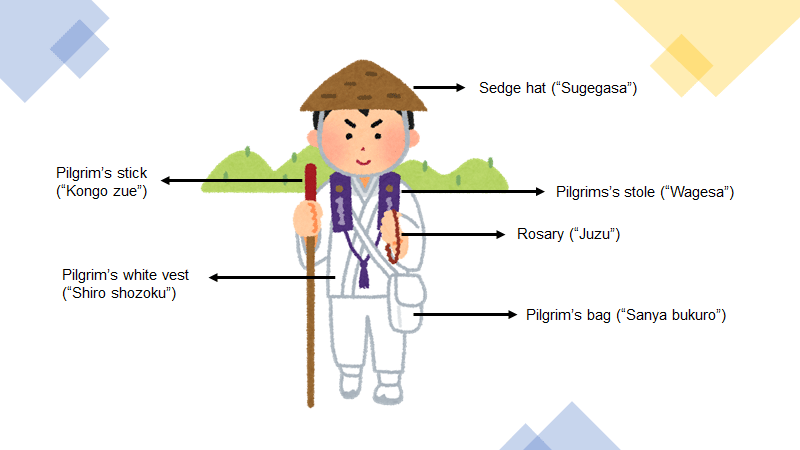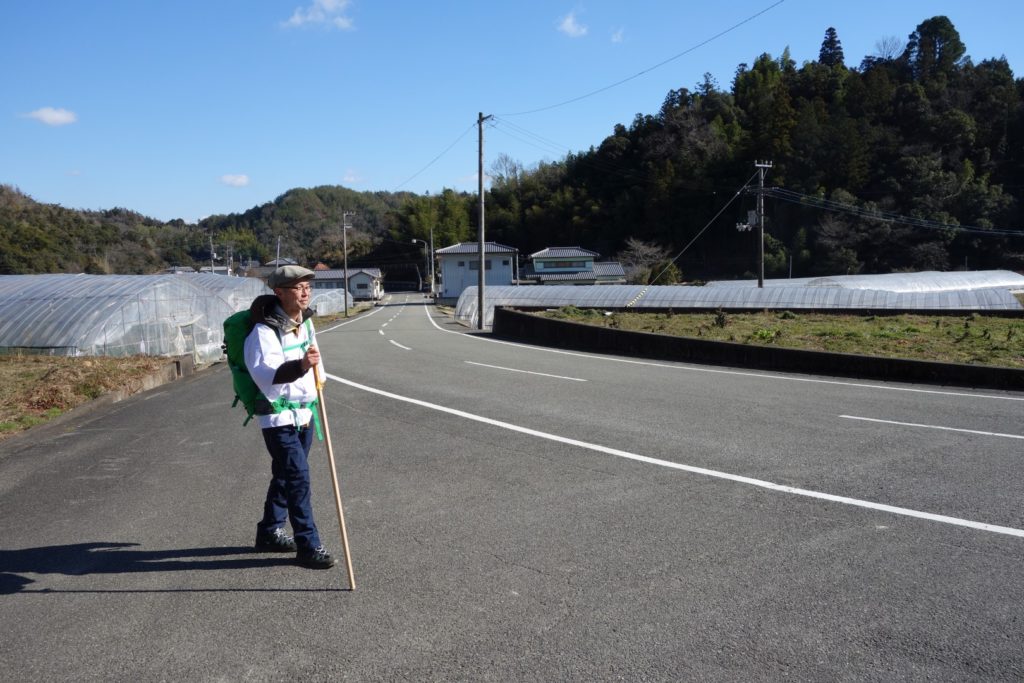
Formal Ohenro-san looks like this. But during my Shikoku Henro pilgrimage, I saw many different arrangement (or even some Ohenro-san didn’t have any of those at all), and I believe that’s pretty OK. I think each one of outfit items have some specific meaning, but let me comment from my experience.
There’re some shops in (or around) No.1 Ryozen-ji, No.2 Gokuraku-ji, No.5 Jizo-ji, No.6 Anraku-ji, No.8 Kumagaya-ji, No.10 Kirihata-ji where you can buy below equipment. I bought them at online shop.
- Sedge hat (Sugegasa) : 3000-4000 JPY
I didn’t buy it without trying it, and I now thought that I should have bought it. I brought folding umbrella and use it when it was raining. But it’s tough to use it for a long time (30-40 km walking!) especially if it’s windy which is quite common when walking along the coast. Sedge hat will also be useful in summer season to avoid strong sunshine. It would be a memorable souvenir after the completion of pilgrimage. - Pilgrim’s stick (Kongo zue): 1000-2000 JPY
This stick is said to be the embodiment of Kobo-Daishi who is the founder of this Shikoku Henro Pilgrimage. It means, you’re not alone during your pilgrimage by bringing it together with you. It is also practically useful when walking in the mountain. I guess it can also be useful to avoid snakes while walking in summer season. I used it from the beginning of the pilgrimage, and it became 15 cm shorter than the original one, after I visited all 88 sacred temples. Such change reminds me how long the trail was. - Pilgrim’s stole (Wagesa): 1500-3000 JPY
It’s part of formal pilgrim’s wear. As Shikoku Henro Pilgrims, I think you’d better to wear it at least when you worship at the temple. Initially, I wore it all the time. However, after I was told that I should take it off when going to restroom, I took it on at the arrival of the temple before worship, and took it off and put it into my pilgrim’s bag when departing to the next temple. - Rosary (Juzu): 2000-3000 JPY
I used it when I worship at the temple. More specifically, I rubbed it three times when I prayed with my hands together. It is said that I can eliminate “Bonno” (earthly desires) by doing it. - Pilgrim’s white vest (Shiro shozoku): 2000-3000 JPY
It is not only white vest, but also white pants are the pilgrims formal wear. However, I only wore white vest. At the backside of this white vest, part of Buddhist sutra (“南無大師遍照金剛”) is printed. By this wear (together with Sugegasa), it’s easy to distinguish who’re pilgrims. - Pilgrim’s bag (Sanya bukuro): 2000-3000 JPY
In this bag, you put things which are necessary when you worship at the temple, such as “Nokyo-cho” in which you’ll get the stamp and signature at each temple, ”Osame-fuda” (votive card), candles, incense sticks.

This is how I looked like during my pilgrimage. I put my “Wagesa” into my “Sanya bukuro” and put it into my backpack. I wore my favorite hat instead of “Sugegasa”. I also selected mountain gear for outwear (to avoid wind and rains), undershirts, shoes and backpacks. It’s simply because there’re some mountain trails during the pilgrimage, and it was winter when I did my pilgrimage. In this picture, I wore pilgrim’s white vest on top of outwear, but I replaced them when it rained.
This backpack weighted 7 kg, and I really felt that it should be lighter as possible. Walking more than 30 km per day with this heavy backpack is actually pretty tough. I’m sure that you’ll pick and select only necessary things even during the pilgrimage :), but let me explain what I brought.
- Backpack
28L. Waist belt was helpful while walking with heavy stuff. - Trekking shoes
Mid-cut with waterproof, to protect ankle, while rough hike. I used it daily for a week before using it for pilgrimage. Mont-bell’s Lapland Strider MID - Gore-tex rain jacket, Gore-tex rain pants
To avoid wind and rain and to keep warm. Selected very light one. - Trekking pants
Used it daily. The one which is easy to dry. - Underwear (x2)
Used it daily both as underwear while walking, and nightwear. Warm and easy to dry. I usually washed it just after the arrival to the guest house, wore the new one for sleep and next day. Mont-bell’s ZEO-LINE M.W shirt - Running pants
Use it for nightwear. Backup for trekking pants. - Underpants (x3)
- Tights
Use it when it’s cold - Thick trekking socks (x3)
It is to avoid shoe soar. - Uniqlo ultra light down
Wore it below Gore-tex rain jacket when it’s cold. Foldable. - Fleece jacket
Wore it daily on top of underwear. - Gloves
Not only to warm hand, but also to protect hand while walking in bush - Foldable umbrella
Maybe I should have used “Sugegasa” instead - Pilgrim’s stick (Kongo-zue)
- Pilgrim’s white vest
- Pilgrim’s bag (Sanya bukuro)
- Pilgrim’s stole (Wagesa)
- Rosary
- Nokyo-cho (stamp book)
Bought the one specific for Shikoku Henro Pilgrimage. For two pages, on one side I can get the stamp, and the other side there’s a picture of the temple with some explanation. - Osame-fuda (Votive card) (x200)
I wrote my name and address beforehand. I put one at main temple, and the other at Taishi-do in each temple. Meaning, at least 88 x 2 = 176 Osame-fuda are needed. - Kyo-hon (Sutra book)
Although I’m not a Buddhist, I wanted to follow a kind of “routine” at each temple. And it includes reciting Sutra, hence I bought a specific Sutra book for Shikoku Henro Pilgrimage. According to it, Shikoku Henro Pilgrims will read some set of Sutra including “Hannya Shingyo (The Heart Sutra)”. In the end, you remember it 🙂 - Candles (for votive lantern) (x200)
At each temple, two candles are needed for votive lantern, one for main temple, and the other for Taishi-do. - Incense sticks (x200)
At each temple, 6 incense sticks are needed. 3 for main temple, and the other 3 for Taishi-do. As a total, 528 incense sticks are necessary, and I bought it at temple when it becomes fewer. - Disposable lighter
To light up candles, incense sticks - Shikoku Japan 88 route guide (Map)
HENRO-MICHI preservation cooperation association published a specific handbook for Shikoku Henro Pilgrimage. I brought its map with me (English version is available). It’s A4 size compact map while covering all the pilgrimage route with list of temples and recommended accommodation. I usually use Google map, but it did not cover all the mountain trail. It was also useful when network was not available. - Compass
In case if I lose my smartphone (or if the battery runs out), map and compass would be important. - GPS logger
To track the location. To do it by mobile phone all the way would consume too much battery. I wanted to avoid battery shortage of mobile phone, since it’s important tool for any emergency case. I also downloaded offline map beforehand, and use GPS logger to identify my location when Google Map cannot be used (no network connection). HOLUX Wireless GPS Logger m-241. - Mobile phone
- Digital Camera
I used SONY’s RX100 in addition to my smartphone camera. It’s small yet very good. - USB cable, charger and mobile battery
Light weigh one with 3000mAh capacity - LED flashlight
To walk in the night (It was really dark outside sometimes) - Tablet & BT keyboard
SONY’s Xperia Tablet Z3 compact and Buffalo’s BSKBB24BK. Both are extremely light weighted. I used it to post some articles on Facebook during my pilgrimage. And take some logs everyday which is now used to write this web site 🙂 - Medicines
- Others
Toothbrush, Some pocket tissues, Nail clipper, Scissors, Shaver, Masks (Use it when I need to walk through long tunnel with a lot of cars), Towels (x2), Handkerchief (x2), Safety pin (Use it when getting blister), Sticking plasters, Taping tape, Thorn remover, Plastic bags
Leave a Reply